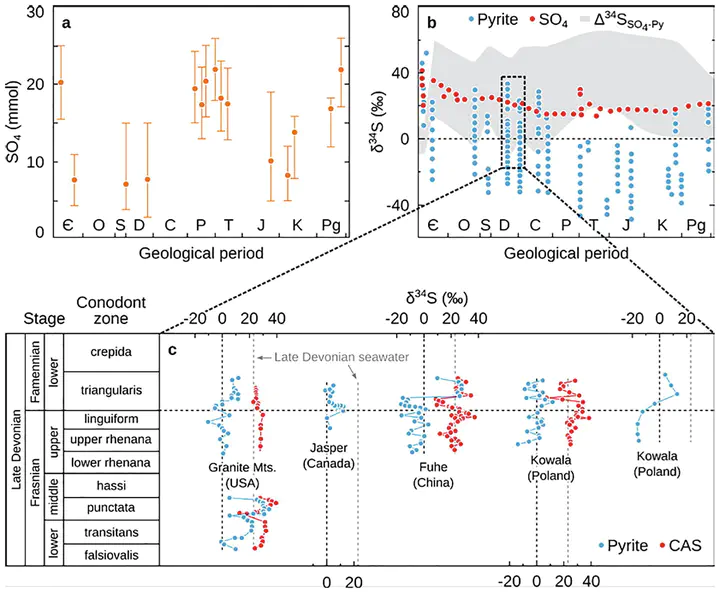Hydrothermally induced $^{34}$S enrichment in pyrite as an alternative explanation of the Late-Devonian sulfur isotope excursion in South China
 (a) Estimates of Phanerozoic seawater sulfate concentrations based on fluid inclusion data from marine evaporates. (b) The sulfur isotope record of Phanerozoic sedimentary pyrite (blue circles) and sulfates (red circles). The shaded area indicates the envelope of observed sulfur isotope fractionations between sedimentary sulfate and pyrite (Δ34Ssulfate-pyrite). (c) The sulfur isotope record of pyrite and carbonate- associated sulfate (CAS) in Late Devonian sedimentary carbonate rocks from the Granite Mountains, USA; Jasper, Canada; Fuhe, China; and Kowala, Poland. The Late Devonian is characterized by a strikingly positive excursion in pyrite sulfur isotope ratios, which are variable in their timing, duration, and magnitude. Some pyrites from that time display extremely positive δ34S values, even higher than that of the inferred Late Devonian seawater sulfate (i.e., δ34Spyrite > δ34Ssulfate; δ34Ssulfate = ∼+23‰; gray dashed line), as reconstructed from CAS in the calcite lattice.
(a) Estimates of Phanerozoic seawater sulfate concentrations based on fluid inclusion data from marine evaporates. (b) The sulfur isotope record of Phanerozoic sedimentary pyrite (blue circles) and sulfates (red circles). The shaded area indicates the envelope of observed sulfur isotope fractionations between sedimentary sulfate and pyrite (Δ34Ssulfate-pyrite). (c) The sulfur isotope record of pyrite and carbonate- associated sulfate (CAS) in Late Devonian sedimentary carbonate rocks from the Granite Mountains, USA; Jasper, Canada; Fuhe, China; and Kowala, Poland. The Late Devonian is characterized by a strikingly positive excursion in pyrite sulfur isotope ratios, which are variable in their timing, duration, and magnitude. Some pyrites from that time display extremely positive δ34S values, even higher than that of the inferred Late Devonian seawater sulfate (i.e., δ34Spyrite > δ34Ssulfate; δ34Ssulfate = ∼+23‰; gray dashed line), as reconstructed from CAS in the calcite lattice.
Abstract
Several Late Devonian sedimentary successions host pyrite with highly positive sulfur isotope values (δ34Spyrite). These anomalous values have been linked to marine anoxia, low sulfate concentrations in seawater, or aerobic re-oxidation of dissolved sulfide within well-oxygenated bottom waters in a local depositional environment. Implicit to these previous models is the assumption of a biogenic genesis from microbial sulfate reduction (MSR) of these pyrites, which, in turn, can be used to understand the biogeochemical sulfur cycle and reconstruct paleoenvironmental conditions. In South China, the Late-Devonian bulk-rock sulfur isotope excursion occurs in the lower Fammenian Wuzhishan Formation of the Youjiang Basin, in both the sedimentary limestone that corresponds to the Late triangularis conodont zone at the Fuhe section and the sediment-hosted Xialei Mn deposit that lies between the Late triangularis and crepida conodont zones. To further constrain the significance of these 34S-enriched pyrites, we carried out detailed textural and in-situ sulfur isotope examinations of pyrites in the Xialei Mn deposit. We found one type of pyrite in siliceous limestone referred to as the host rocks and three distinct pyrite types in Mn ores: Type I – pyrites with Mn-carbonate inclusion-rich cores; Type II – pyrite overgrowths surrounding an “inclusion-rich” core; and Type III – relatively inclusion-poor and mainly subhedral disseminated pyrite grains. Type I pyrites in Mn ores have negative δ34Spyrite values from -7.8‰ to -2.0‰. Types II and III pyrites, and pyrites in the host rock are characterized by highly positive δ34Spyrite values (+4.2‰ to +37.6‰), with some values being higher than that of contemporaneous seawater sulfate. Type I pyrites with negative δ34S values likely formed via MSR in a closed porewater system, driven by increased sedimentation rates during a sea level lowstand. The other pyrites with highly positive δ34S values appear to have formed during secondary hydrothermal alteration, with their sulfur sourced through thermochemical sulfate reduction (TSR) of sulfate from dissolved barites in the underlying Liujiang Formation. This implies that the positive δ34S values of the Late Devonian pyrites from the Wuzhishan Formation represent a later alteration event caused by post-depositional hydrothermal fluids, and may lack a direct biogeochemical connection to the surface sulfur cycle. These results provide an important perspective on the origin of variability in sulfur isotope records and suggest the need for careful petrographic screening and micrometer-scale analysis of sedimentary units used to reconstruct paleoenvironmental conditions.